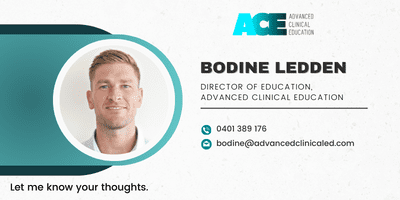It’s all about the ABC’s
Who is responsible for achieving your goals?
The answer lies in self-efficacy. This is defined as the belief in your ability to accomplish what you set out to do. Improving self-efficacy requires positive internal beliefs rather than relying on external assistance.
In clinical practice very early in the consultation process, I will discuss with my patient why they are here to see me and what do they want to get out of this session. Often, the underlying reason is that their pain is interfering with their life or something they enjoy doing. So, it comes back to:
- What do they believe is the problem?
- What do they believe are they main barriers to progression?
- What strategies do they use to cope with their current situation?
- How long do they expect it will take to return to x activity?
- How do they see their future and their ability to manage pain?
- What do they want from me/this session?
By establishing patient expectations and gaining insights into their beliefs, coping strategies and level of self-efficacy, we as clinicians can create a plan for education, goal setting and progression.
Following this discussion, it is important to then ask…
- Based on these changes/strategies discussed in this plan, how confident are you that you will be able to stick to it long-term?

Pain is often associated with negative coping strategies, unhelpful beliefs, and low self-efficacy. To effectively address pain, it is important to identify the behaviours that contribute to pain and the consequences of those behaviours.
When I ask a patient, “What do you believe are the main contributors to your pain?”, their answers are often vague or focused on mechanical causes. This focus on pain as a consequence and prevents them from identifying potential contributors that precede their pain related behaviours.
Patients often expect clinicians to “fix their pain.” However, persistent pain is often more challenging than a mechanical fix. Improvement requires patient engagement and involvement in the process.
Consider these two perspectives:
- Passive coping: “My back hurts, so I won’t exercise, and I need someone to fix this. I don’t want to do more damage”
- Active coping: “My back hurts. I had poor sleep, I am currently experiencing high stress, and I have been eating and unhealthy diet. I’ll exercise tonight to reduce stress, get a good night’s sleep and get back on track with healthy eating.
Being more mindful of the antecedents (stress, mood, environment etc.) will influence the behaviour (exercise, sleep, diet etc.) and therefore the consequence of the behaviour (active coping vs passive coping) as an example. These ABC’s will vary for the individual.

Consider this…
All behaviours (B) have an antecedent (A) and a consequence (C) and all behaviours have a function (Watson & Tharp, 2014). By understanding these components, we as clinicians can guide our patients toward healthier coping mechanisms and positive behavioural change.
The ABCVO model breaks this down:
A) The antecedent is the trigger that is related to their beliefs and the context of the onset of their pain. For example, low back pain that was triggered by lifting a heavy box.
B) The behaviour in the short-term may be using passive coping like medications, manual therapies and avoidance of similar tasks or physical activities in general.
C) The consequences of the behaviour may provide short term relief, however in the long-term reliance of passive coping may have negative physical and psychological effects leading to chronicity.
VO) The valued outcome is the function of that behaviour (why we do that behaviour).
Using this model helps patients understand why they engage in certain behaviours and how these actions impact their pain experience.
It is important to remember that just like persistent pain, behavioural change takes time, often months or years and requires patients to observe their own cognitive and emotional responses. By becoming more observant of these factors, patients can shift their focus from what causes pain to why it persists. This insight empowers them to adopt healthier behaviours, manage pain more effectively, and regain control over their lives.


